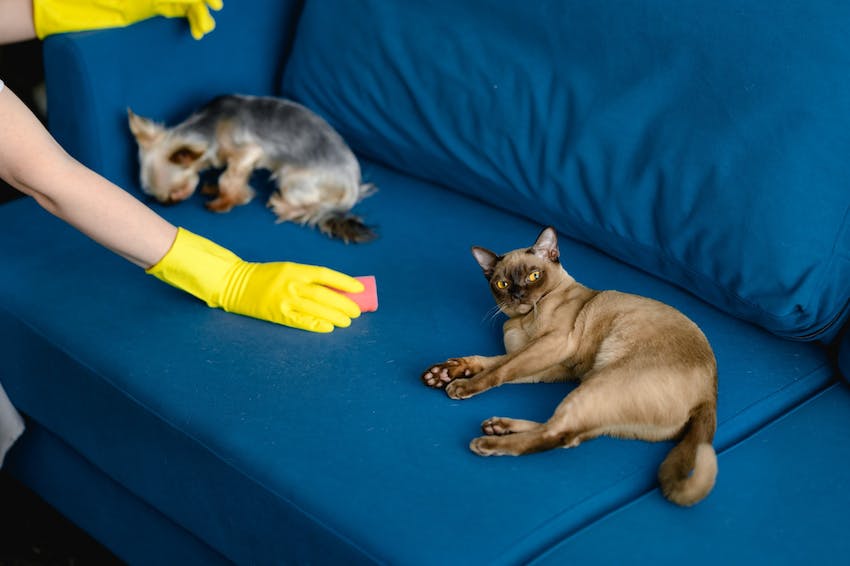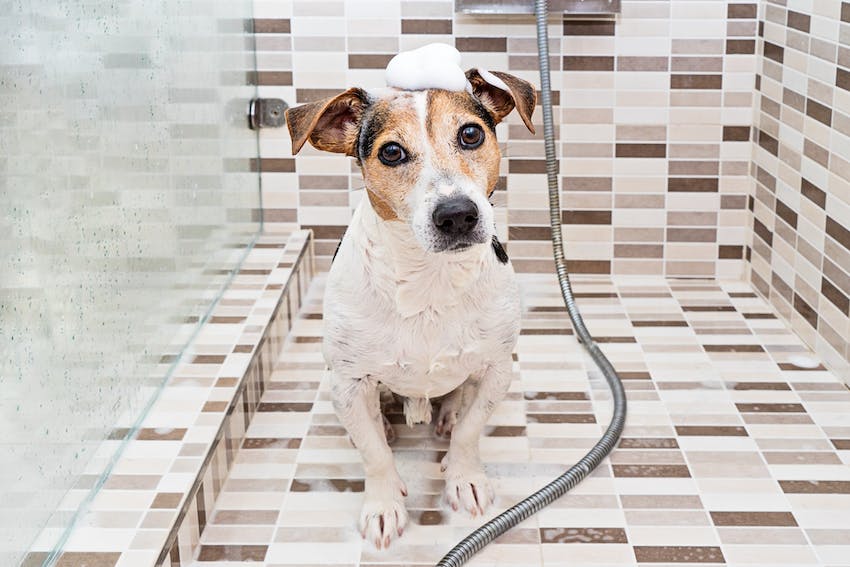Ready to help treat your pet to a healthy life?
How to Get Rid of Fleas: A Guide for Pet Owners
By : Brianna Gunter | Updated Sep 5, 2024
Keep in mind that bringing a pet with fleas to a veterinary practice is not recommended, as this can easily spread the infestation to other animals.
2. Bathe your pet
Thoroughly bathing your pal from head to toe is among the most necessary parts of pet flea treatment. Ideally, you’ll want to take a longer time than you would during a normal pet bath, going until you no longer see any fleas being rinsed out. Choose your soap wisely too. According to Pet Keen, common household dish soap offers a gentler option for pets with highly irritated skin, but it may not be the most effective in killing fleas.
If you live in a multi-pet household, bathe all animals regardless of whether they are visibly affected by fleas as a precaution. Bonus tip—you may want to trim your cat’s nails first (you don’t need scratches on top of your flea battle).
3. Use a flea treatment
In addition to bathing with soap, a flea treatment with insecticide is needed to handle infestations that go beyond just a few bugs (which is most by the time they’re noticed). Since flea treatments come in a variety of forms (including topical and oral variants), talk with your veterinarian about which will be the safest, most effective option for your pet.
Flea treatment is generally not covered by pet insurance, as infestations are considered preventable. (Learn more about the wide range of conditions Trupanion covers).
4. Don’t just focus on adult fleas
In order to beat a flea infestation long-term, it’s vital to tackle all stages of the flea life cycle. Use a flea comb to carefully go through your pet’s fur and remove any traces of the little bugs, from eggs to larvae to adults.
Don’t forget about “flea dirt” either! These small specks of brown material (some pet owners liken it to black pepper) are actually digested blood from your pet that adult fleas leave behind. Hatching larvae eat this material, so be sure to remove any flea dirt that you come across.
5. Clean your home
Fleas tend to breed and congregate in bedding, blankets, couches, and rugs. That said, they can be found on all kinds of surfaces throughout your home. In order to prevent new fleas from making their way onto your pet, it’s vital to clean everything from top to bottom. Don’t forget to clean under rugs and alongside wall edges.
Remember—treating your pet directly is only half the battle. Keeping your home clean throughout will help prevent spread and reoccurrence.
6. Repeat
Fleas have a complex life cycle that leaves them more resistant to flea treatment insecticides at certain point of their lifespan. At the same time, the fleas on your pet are likely at all different life stages. In order to make sure they’re all vanquished, you’ll need to repeat topical treatments within a week after the first application. Deep house cleaning should also be continued throughout this period.
More severe infestations may require treatment and cleaning repetition for months, but talk with your veterinarian if you feel the problem is not improving.
7. Consider professional assistance
While consistent cleaning and flea treatment will go a long way, severe infestations may require heavier lifting. You may want to hire a pest control service to ensure your home is flea-free, for example. Likewise, some professional pet groomers offer specialized services for flea prevention and treatment.
Flea prevention for pet wellness
Fleas may be hard to detect in the first place, and they can be even harder to get rid of. So, it's important for all pet parents to take preventative measures. This starts with keeping a clean home and ensuring that your pet receives routine baths and grooming. But seeing as fleas can still pop up in even the best-kept spaces, you'll still want to take additional measures.

“Naturally, the best course of action is to have all your pets on effective veterinarian recommended flea prevention,” Nold says. “It’s much easier to prevent fleas than to get rid of a flea infestation.”
Conveniently, flea and tick prevention treatment is often combined into one easy-to-apply dose. Consider keeping a monthly calendar for your pet’s flea prevention medication. Even one missed treatment can leave your pet open as a prospective home for pests.
To get pet care and wellness delivered straight to your inbox, sign up for our newsletter!




